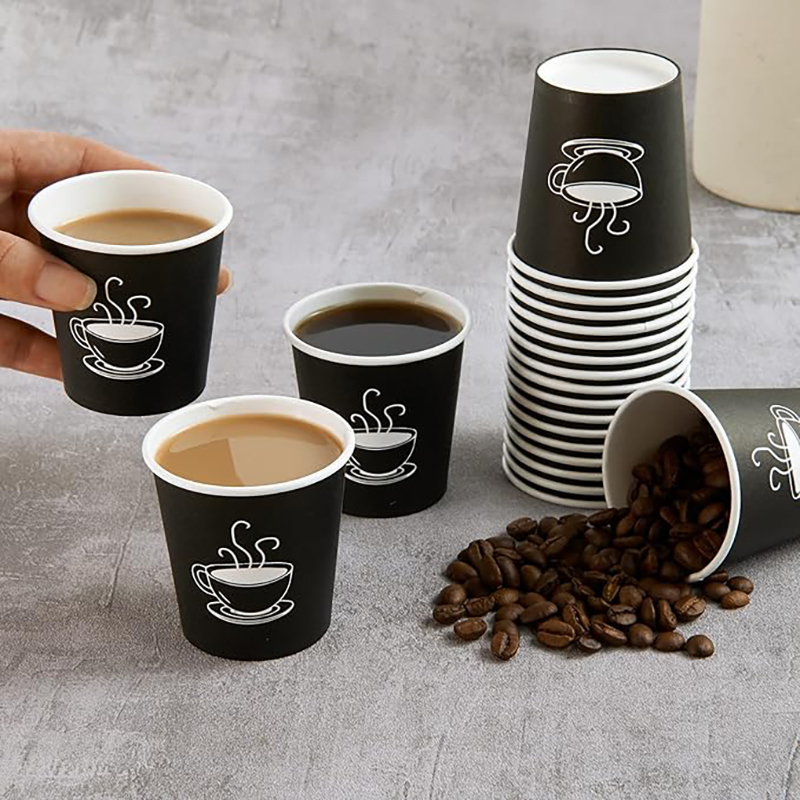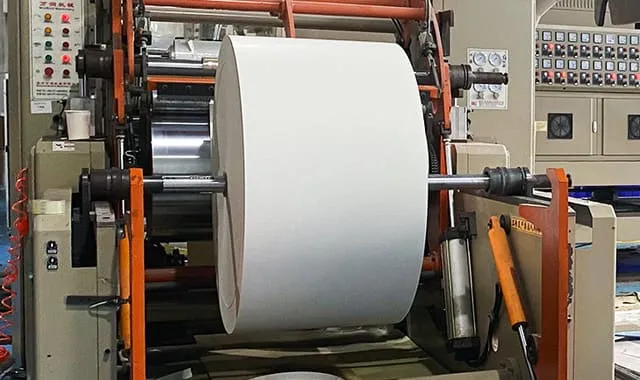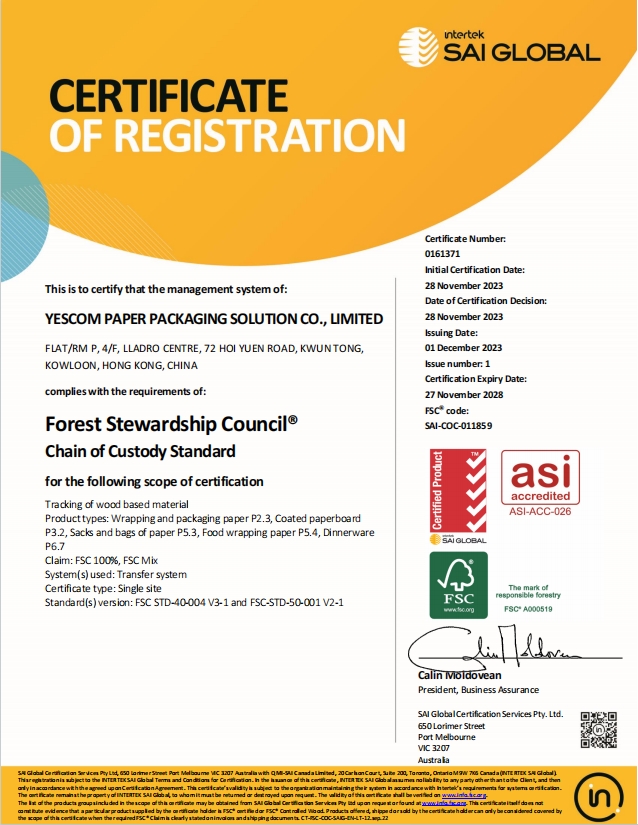الشركة المصنعة للورق المخصص للأكواب
مُصنِّع ورق الأكواب الموثوق به
ما هو ورق الأكواب؟ بصفتها الشركة الرائدة في تصنيع ورق الأكواب، تتخصص Yescom Paper في صناعة الورق المقوى المتين والمقاوم للرطوبة لتغليف الأطعمة والمشروبات، وتوفر مجموعة من المنتجات المستدامة القابلة للتخصيص.
المنتجات التي نقدمها
- ورق قاعدة الأكواب
- بى بى ورق الكؤوس المغلف
- عشاق الكؤوس
- أكواب ورقية وأوعية ورقية
يمكننا توفير الأكواب كمادة خام وإنتاج منتجات ورقية تامة الصنع

الآلات التي لدينا
- ماكينة الترقق
- ماكينة طباعة
- مطبعة الأوفست بالأشعة فوق البنفسجية
- ماكينة قص القوالب
جميع الماكينات متاحة لإنتاج منتجات الأكواب الجاهزة من ورق قاعدة الأكواب.

مجلس رعاية الغابات
- المصداقية
- التأمين
- الاستدامة
- الوصول إلى الأسواق
- الجدوى الاقتصادية
- المسؤولية الاجتماعية
- الحفاظ على البيئة
- الإدارة المسؤولة للغابات
شهادة مجلس الإشراف على الغابات (FSC) هي شهادة مهمة تضمن الإدارة المسؤولة للغابات. وهي شهادة معترف بها عالميًا تضمن أن منتجات الغابات، مثل الأخشاب والورق، تأتي من غابات تدار بطريقة مسؤولة.

لماذا تختارنا
أسعار تنافسية
عرض خاص من الشركة المصنعة للورق
مصنع التملك الذاتي
لدينا كل من مصنع الطلاء والورق مصنع إنتاج الأكواب.
مواد احترافية
10 سنوات أخرى من الخبرة
بصفتها شركة رائدة في تصنيع ورق الأكواب، تفخر شركة Yescom للورق المقوى بتوريد مواد ورقية فائقة الجودة مصممة خصيصًا لصناعة الأغذية والمشروبات.
فيمَ يُستخدَم المخزون الكوبي؟
إن Cupstock هو نوع متخصص من الورق المقوى المصمم خصيصًا لإنتاج الأكواب وغيرها من عبوات الأطعمة والمشروبات. يتم تصنيعه من مزيج من المواد الخام، بما في ذلك لب الخشب والطلاءات المختلفة، لإنشاء مادة متينة ومقاومة للرطوبة. يلعب ورق الأكواب دورًا حاسمًا في صناعة الأغذية والمشروبات حيث يوفر طريقة آمنة ومريحة لتعبئة وتقديم مجموعة كبيرة من المنتجات.
أهمية مخزون الأكواب في صناعة الأغذية والمشروبات
استخدام الكوب يوفر ورق تغليف الأطعمة والمشروبات فوائد عديدة. أولاً, ورق الأكواب يوفر عزلًا ممتازًا خصائص الحفاظ على المشروبات الساخنة ساخنة وباردة لفترات زمنية أطول. هذا الأمر مهم بشكل خاص للشركات العاملة في صناعة القهوة والشاي، حيث يعد الحفاظ على درجة حرارة المشروبات أمراً بالغ الأهمية لرضا العملاء.
بالإضافة إلى ذلك، فإن ورق الأكواب قابل للتخصيص بدرجة كبيرة، مما يسمح للشركات بطباعة شعاراتها وعلاماتها التجارية وغيرها من التصميمات مباشرةً على الأكواب. لا يعزز هذا الأمر من ظهور العلامة التجارية فحسب، بل يخلق أيضًا مظهرًا احترافيًا ومتماسكًا للشركة. علاوة على ذلك، فإن الأكواب الورق خفيف الوزن وسهولة التعامل معها، مما يجعلها مريحة لكل من الشركات والمستهلكين.
كما ساهم طلب المستهلكين على التعبئة والتغليف المستدام والصديق للبيئة في زيادة أهمية الأكواب الورق في صناعة الأغذية والمشروبات. مع زيادة الوعي بالقضايا البيئية، يبحث المستهلكون بنشاط عن المنتجات المعبأة في مواد قابلة لإعادة التدوير أو مصنوعة من مصادر مستدامة. استجابت الشركات المصنعة للأكواب لهذا الطلب من خلال تطوير خيارات صديقة للبيئة تلبي توقعات المستهلكين والمتطلبات التنظيمية.
المواد الخام المستخدمة في تصنيع الكؤوس الزجاجية
ينطوي تصنيع الأكواب على استخدام العديد من المواد الخام، بما في ذلك لب الخشب والطلاء والمواد المضافة. لب الخشب هو المكون الأساسي المستخدم في إنتاج ورق الأكواب، ويتم الحصول عليه من الغابات المدارة بشكل مستدام أو المنتجات الورقية المعاد تدويرها. تتم معالجة اللب لإزالة الشوائب ثم يتم خلطه بالماء لتكوين ملاط.
يتم وضع الطلاء على ورق الكوب لتعزيز قوته ومتانته ومقاومته للرطوبة. عادةً ما تكون هذه الطلاءات مصنوعة من البولي إيثيلين، وهو نوع من البلاستيك يوفر حاجزًا ضد السوائل. يمكن أيضًا تضمين إضافات مثل مواد الحشو والمواد الرابطة في تركيبة ورق الأكواب لتحسين خصائصه.
مصادر مستدامة للمواد الخام المواد هي أحد الاعتبارات الرئيسية للأكواب الشركات المصنعة للورق. وقد طبقت العديد من الشركات ممارسات التوريد المسؤول، مما يضمن أن لب الخشب المستخدم في إنتاج الأكواب الورقية يأتي من مصادر مستدامة معتمدة. وهذا يساعد على حماية الغابات والتنوع البيولوجي مع دعم المجتمعات المحلية التي تعتمد على موارد الغابات.
عملية تصنيع مخزون الأكواب: من اللب إلى المنتج النهائي
| تحضير اللب | نوع اللب | عذراء أو معاد تدويرها |
| اتساق اللب | 10-15% | |
| تبييض اللب | خالي من الكلور | |
| تشكيل الكوب | حجم الكوب | 8 أونصات، 12 أونصة، 16 أونصة، إلخ. |
| سُمك جدار الكوب | 0.25 - 0.35 مم | |
| شكل الكوب | مستديرة أو مربعة | |
| الطباعة والقص | طريقة الطباعة | الفلكسوغرافي أو الأوفست |
| ألوان الطباعة | ما يصل إلى 6 ألوان | |
| نوع القطع | قطع القوالب أو المقصلة | |
| التشطيب | الطلاء | PE أو PLA |
| التعبئة والتغليف | مخصص أو قياسي |
تنطوي عملية تصنيع اللب الخشبي على عدة خطوات، كل منها حاسم في ضمان جودة وأداء المنتج النهائي. تبدأ العملية بتحضير لب الخشب، الذي يتم تنقيته وخلطه بالماء لتكوين ملاط. ثم يتم تشكيل هذا الملاط إلى صفائح باستخدام ماكينة الورق.
بمجرد تشكيل الأوراق، تخضع لسلسلة من المعالجات لتحسين خصائصها. ويشمل ذلك وضع الطلاء على جانبي الورق المقوى لتوفير مقاومة للرطوبة وتحسين قابلية الطباعة. ثم يتم تجفيف الألواح المغلفة وتقطيعها إلى الحجم المطلوب لإنتاج الأكواب.
يتم تنفيذ تدابير مراقبة الجودة طوال عملية التصنيع لضمان استيفاء ورق الأكواب للمعايير المطلوبة. ويشمل ذلك اختبار القوة ومقاومة الرطوبة وقابلية الطباعة. يتم تحديد أي عيوب أو تناقضات ومعالجتها للحفاظ على جودة المنتج.
أنواع الأكواب: مغلفة بالبولي إيثيلين أحادي الجانب ومزدوج الجانب
يتوفر ورق الأكواب في نوعين رئيسيين: ورق الأكواب المطلي بالبولي إيثيلين أحادي الجانب (SSPE) والبولي إيثيلين المطلي على الوجهين (DSPE). يكمن الفرق الرئيسي بين هذين النوعين في عدد الجوانب المطلية بالبولي إيثيلين.
يحتوي غلاف الأكواب SSPE على جانب واحد مطلي بالبولي إيثيلين، مما يجعله مناسبًا لأكواب المشروبات الباردة أو الحاويات التي لا تتطلب مستويات عالية من مقاومة الرطوبة. ومن ناحية أخرى، فإن أكواب الأكواب DSPE، من ناحية أخرى، مغلفة من كلا الجانبين بالبولي إيثيلين، مما يوفر مقاومة فائقة للرطوبة ويجعلها مثالية لأكواب المشروبات الساخنة أو الحاويات التي تلامس السوائل مباشرةً.
يعتمد الاختيار بين أكواب SSPE و DSPE على الاستخدام المحدد ومتطلبات المنتج. على سبيل المثال، قد تختار الشركات العاملة في صناعة الوجبات السريعة استخدام أكواب DSPE لضمان عدم تسرب المشروبات الساخنة أو التسبب في تبلل الأكواب. وفي الوقت نفسه، قد تجد الشركات التي تقدم المشروبات الباردة في المقام الأول أن أكواب SSPE خيارًا أكثر فعالية من حيث التكلفة.
مزايا استخدام الأكواب في تغليف الأطعمة والمشروبات
توفر أكواب الأكواب العديد من المزايا مقارنةً بمواد التغليف الأخرى عندما يتعلق الأمر بتغليف الأطعمة والمشروبات. أولاً، الأكواب الورق متين للغاية ويوفر متانة عالية ويوفر خصائص العزل. وهذا يعني أنه يمكن أن يحافظ على المشروبات الساخنة ساخنة وباردة لفترات طويلة من الوقت، مما يضمن رضا العملاء.
علاوةً على ذلك، فإن ورق الأكواب قابل للتخصيص بدرجة كبيرة، مما يسمح للشركات بطباعة شعاراتها وعلاماتها التجارية وغيرها من التصميمات مباشرةً على الأكواب. لا يعزز ذلك من ظهور العلامة التجارية فحسب، بل يخلق أيضًا مظهرًا احترافيًا ومتماسكًا للشركة. تساعد القدرة على تخصيص عبوات الأكواب الورقية الشركات على التميز في سوق تنافسية وتترك انطباعًا دائمًا لدى المستهلكين.
فعالية التكلفة هي ميزة أخرى لاستخدام ورق الأكواب لتغليف الأطعمة والمشروبات. ورق الأكواب خفيف الوزن، مما يقلل من تكاليف الشحن ويسهل على الشركات التعامل مع كميات كبيرة من الأكواب وتخزينها. بالإضافة إلى ذلك، غالبًا ما يكون ورق الأكواب أقل تكلفة مقارنةً بمواد التغليف الأخرى مثل الزجاج أو البلاستيك، مما يجعله خيارًا جذابًا للشركات التي تتطلع إلى تقليل التكاليف دون المساس بالجودة.
تدابير مراقبة الجودة في تصنيع الأكواب
تُعد مراقبة الجودة جانبًا مهمًا في عملية تصنيع مخزون الأكواب لضمان استيفاء المنتج النهائي للمعايير المطلوبة. تطبق الشركات المصنعة للأكواب تدابير مختلفة لمراقبة الجودة خلال عملية التصنيع لتحديد ومعالجة أي عيوب أو تناقضات.
يتمثل أحد الجوانب المهمة لمراقبة الجودة في اختبار قوة ومتانة ورق الأكواب. يتضمن ذلك إخضاع المادة لاختبارات إجهاد مختلفة، مثل قياس مقاومتها للتمزق أو الثقب. بالإضافة إلى ذلك، يتم اختبار ورق الأكواب لمقاومة الرطوبة للتأكد من قدرته على تحمل ملامسة السوائل بفعالية دون أن يصبح رطبًا أو يتسرب.
تعد قابلية الطباعة جانبًا رئيسيًا آخر من جوانب مراقبة جودة ورق الأكواب. تجري الشركات المصنعة لورق الأكواب اختبارات للتأكد من إمكانية الطباعة على المواد بفعالية دون تلطيخ أو بهتان. ويشمل ذلك اختبار تقنيات الطباعة والأحبار المختلفة لتحديد أفضل الخيارات لتحقيق مطبوعات عالية الجودة وطويلة الأمد.
مستقبل صناعة الكؤوس: الاتجاهات والابتكارات
مستقبل تصنيع الأكواب الورقية تتشكل من خلال الاتجاهات والابتكارات الناشئة في صناعة تغليف الأغذية والمشروبات. ويتمثل أحد الاتجاهات الرئيسية في الطلب المتزايد على حلول التغليف المستدامة. فقد أصبح المستهلكون أكثر وعيًا بالتأثير البيئي لخياراتهم ويبحثون بنشاط عن المنتجات المعبأة في مواد قابلة لإعادة التدوير أو مصنوعة من مصادر مستدامة. تستجيب الشركات المصنعة للأكواب لهذا الطلب من خلال تطوير خيارات صديقة للبيئة تلبي توقعات المستهلكين والمتطلبات التنظيمية.
هناك اتجاه آخر يتمثل في تزايد شعبية التخصيص في تغليف الأطعمة والمشروبات. تدرك الشركات أهمية العلامة التجارية وخلق تجربة فريدة للعملاء. يستثمر مصنعو الأكواب في تقنيات الطباعة المتقدمة التي تسمح بطباعة مطبوعات عالية الجودة وقابلة للتخصيص على الأكواب. يتضمن ذلك خيارات للطباعة بالألوان الكاملة والتصميمات المعقدة وحتى الأكواب المخصصة للمناسبات الخاصة أو العروض الترويجية.
كما تعمل الابتكارات في مواد التغليف المستدامة على تشكيل مستقبل صناعة الأكواب. يستكشف الباحثون والمصنعون المواد الخام البديلة التي لها تأثير بيئي أقل مع توفير الخصائص اللازمة لتغليف الأغذية والمشروبات. ويشمل ذلك المواد المشتقة من النفايات الزراعية، مثل تفل قصب السكر أو الخيزران، بالإضافة إلى الخيارات القابلة للتحلل الحيوي أو القابلة للتسميد.
دور الشركات المصنعة للأكواب في صناعة الأغذية والمشروبات
وختامًا، يلعب ورق الأكواب دورًا حيويًا في صناعة الأغذية والمشروبات من خلال توفير حل تغليف آمن ومريح ومستدام. الشركات المصنعة للأكواب يعملون باستمرار على تحسين جودة منتجاتهم وأدائها مع تقليل تأثيرها على البيئة. ومن خلال التوريد المسؤول، وعمليات التصنيع الفعالة والحلول المبتكرة، تلبي الشركات المصنعة للأكواب طلب المستهلكين على خيارات التعبئة والتغليف المستدامة وتساعد الشركات على خلق صورة إيجابية للعلامة التجارية. مع استمرار تطور الصناعة، ستلعب الشركات المصنعة للأكواب دورًا حاسمًا في تشكيل مستقبل تغليف الأغذية والمشروبات.
الأسئلة الشائعة
ما هو كوب ستوك؟
Cupstock هو نوع من أنواع الورق المقوى المصمم خصيصًا لإنتاج الأكواب الورقية وغيرها من منتجات تغليف المواد الغذائية.
ما هي فوائد استخدام الورق المقوى المصنوع من الورق المقوى؟
ورق مقوى الأكواب هو مادة متينة ومقاومة للرطوبة ومثالية لتطبيقات تغليف المواد الغذائية. كما أنه قابل لإعادة التدوير ويمكن تصنيعه من مواد مستدامة، مما يجعله خياراً صديقاً للبيئة.
ما هي أنواع المنتجات التي يمكن تصنيعها من الورق المقوى الكوبي؟
يُستخدم الورق المقوى Cupstock الورقي في المقام الأول لإنتاج الأكواب الورقية، ولكن يمكن استخدامه أيضًا في منتجات تغليف المواد الغذائية الأخرى مثل حاويات الوجبات الجاهزة وصواني الطعام وعلب الوجبات الخفيفة.
ما هي بعض الاعتبارات الرئيسية عند اختيار الشركة المصنعة للأكواب؟
عند اختيار الشركة المصنعة للأكواب، من المهم مراعاة عوامل مثل جودة منتجاتها وقدرتها الإنتاجية وأسعارها والتزامها بالاستدامة والمسؤولية البيئية. من المهم أيضًا اختيار الشركة المصنعة التي يمكنها توفير تسليم منتجاتها بشكل موثوق وفي الوقت المناسب.

